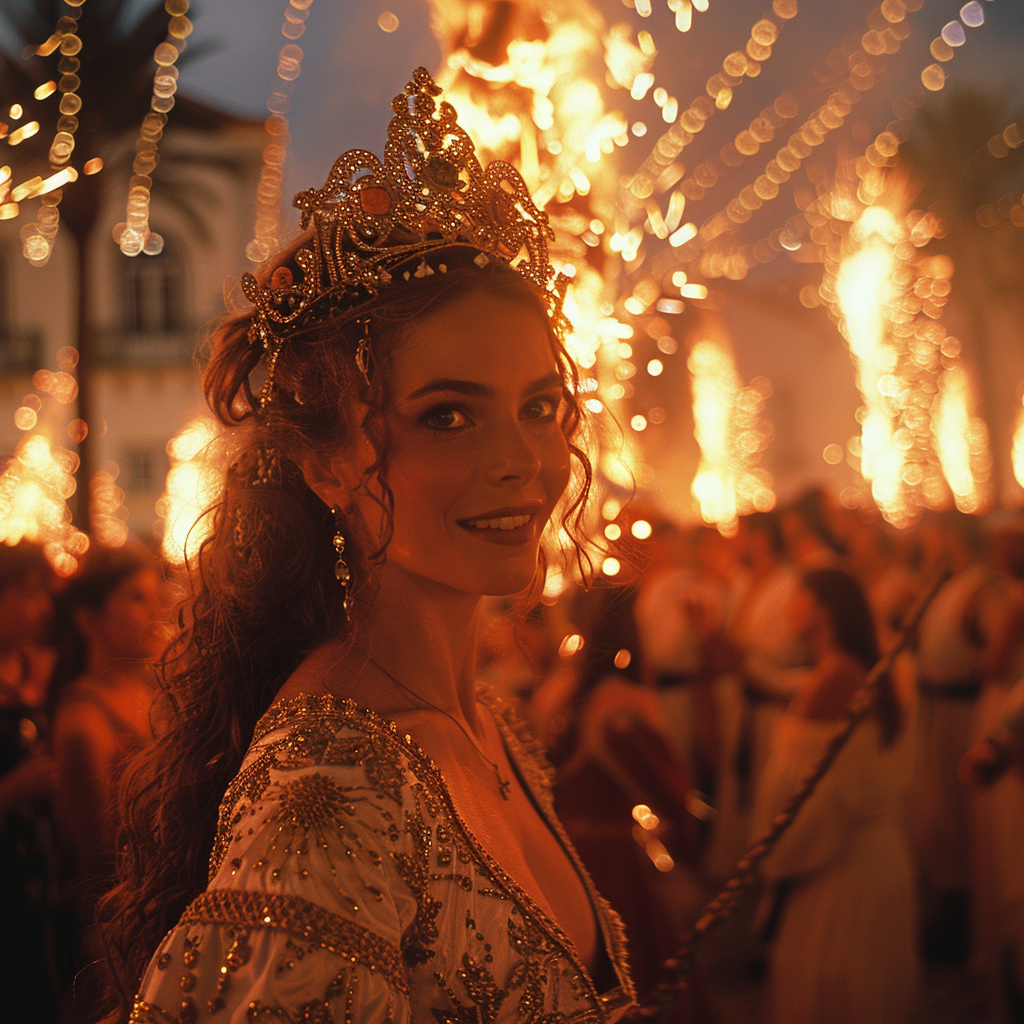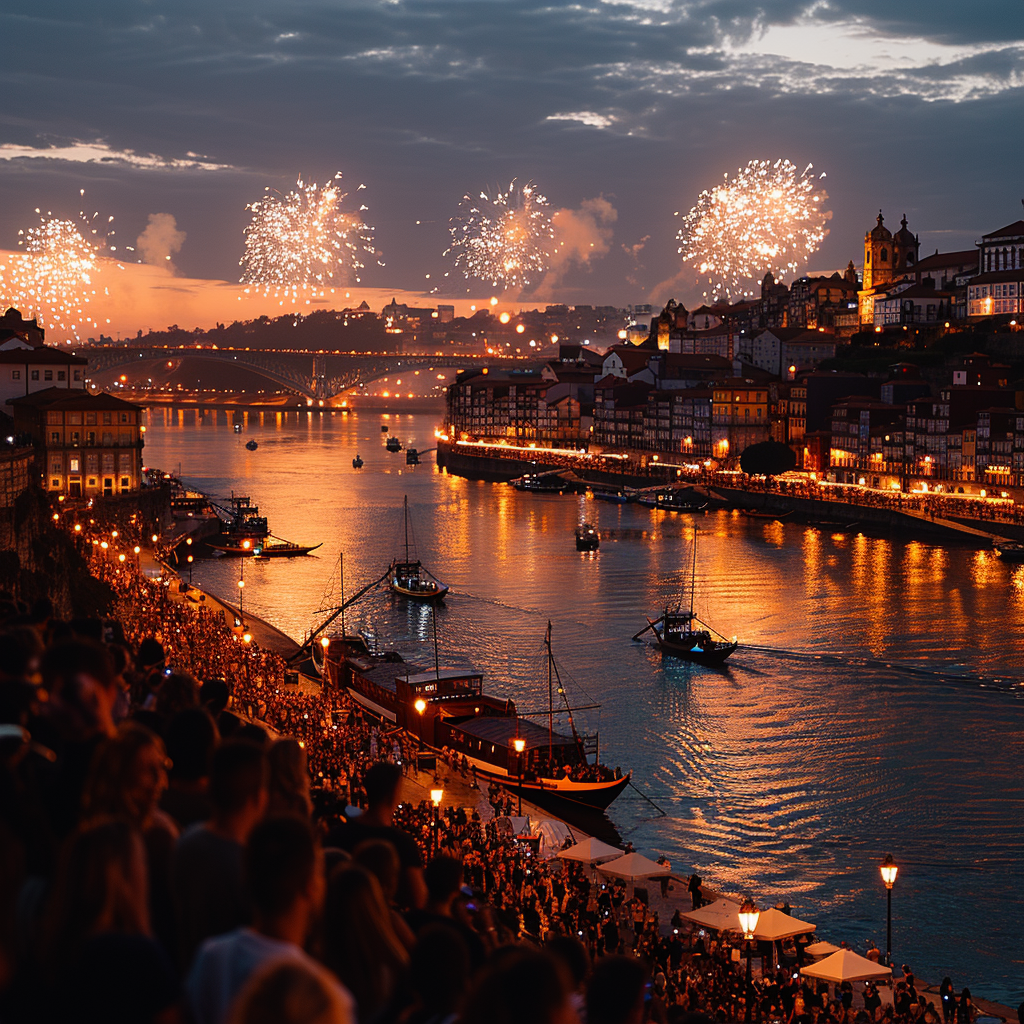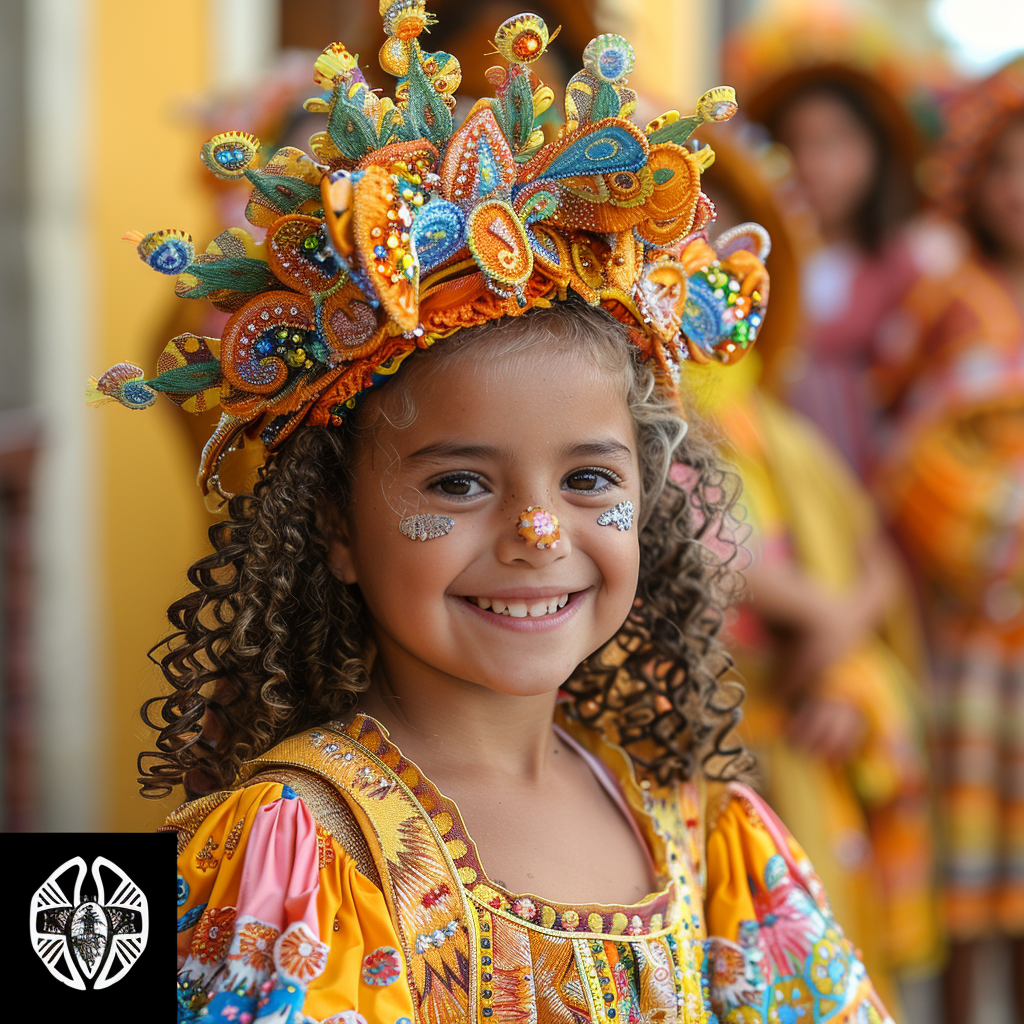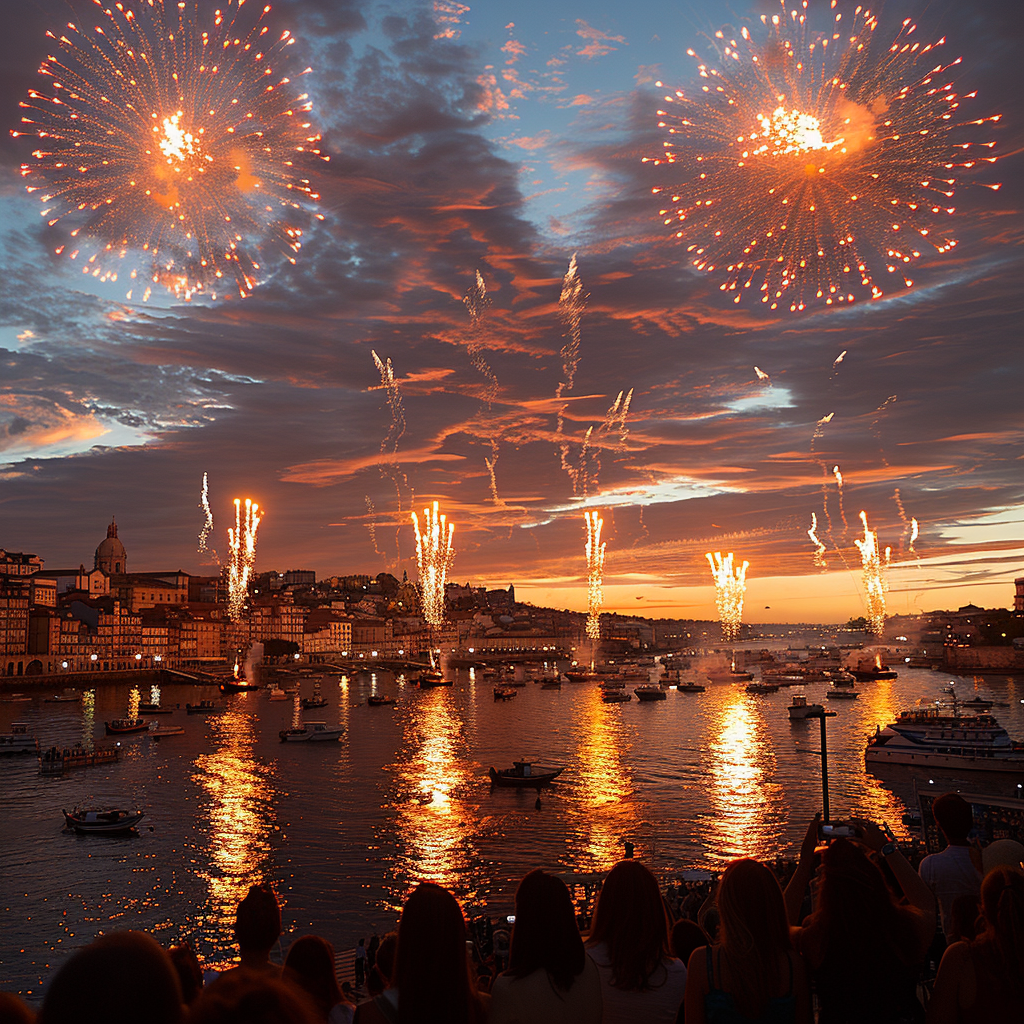Good Morning
Between Fire and Tradition: The Magical Night of Saint John in Portugal 🇵🇹
Welcome to the Heart of Saint John's Festivities 🎉 in Portugal, an event that transforms the shortest night of the year into a spectacular celebration of traditions, fires, and conviviality. In Portugal, this ancient celebration, held around June 24, is marked by iconic rituals that blend local folklore with festivities that stretch from dusk till dawn.
Saint John, locally known as São João, is famous for its popular dances, colorful processions, and impressive bonfires, where participants jump over the flames in the hope of purifying their spirits and bringing luck for the year ahead. An essential part of the celebration is the feast: the streets are filled with the aromas of grilled sardines and meat skewers, while pastéis de nata and other local sweets delight the palates of revelers.
This celebration 🎇 is not just a gathering; it is a pillar of Portuguese culture, reflecting the richness of heritage and the importance of community traditions. Each city and village adds its own touch to the festivities, making Saint John a mosaic of customs that paints a vibrant picture of Portugal's cultural diversity.
Join us as we explore how Saint John is celebrated in Portugal, a spectacle of joy and sharing that lights up the night and warms the hearts.

Let’s dive into the historical roots and fascinating origins of the Saint John’s Festival 🌟 in Portugal, a celebration that seamlessly blends both Christian tradition and pagan heritage. This chapter reveals how the Portuguese transformed an ancient celebration into a vibrant symbol of their culture and identity.
Saint John’s Day, or São João in Portuguese, has its origins in pagan rituals celebrating the summer solstice, the time when the days are longest and the nights are shortest of the year. This period was traditionally associated with the fertility of the earth and the celebration of light.
With the arrival of Christianity, these ancient practices were integrated into the Christian calendar in honor of Saint John the Baptist. The date of June 24 was chosen to coincide with the supposed birth of Saint John, six months before that of Jesus, reflecting the biblical verse that says John must "decrease" as Jesus must "increase."
Over the centuries, the traditions associated with Saint John have evolved but have always retained their essence as a festival of light and fire. Especially in Portugal, this celebration 🎊 has been enriched with local customs that vary from region to region, offering a mosaic of unique celebrations.
This chapter also explores how Saint John’s Day has become an integral part of Portuguese identity, marking the start of summer each year with hope and renewal. Through the festival, communities gather to celebrate, sharing meals, dances, and, of course, the captivating spectacle of bonfires.

Let’s explore together the rituals and traditions 🎆 that make Saint John’s Day in Portugal such a unique and unforgettable celebration. Each region brings its personal touch to this festivity, creating a vibrant patchwork of customs that light up the shortest night of the year.
One of the most iconic elements of Saint John’s Day is the bonfire, or 'fogueiras'. Symbolizing purification and renewal, these fires provide an opportunity for participants to jump over the flames, an act believed to bring luck and health for the coming year. 🌟
In addition to the bonfires, the festival is also marked by community meals, where grilled sardines and caldo verde (a traditional Portuguese soup) dominate the menus, reflecting the richness of Portuguese gastronomy during the festivities. The streets also come alive to the sound of plastic hammers in Porto, a recent addition that has become indispensable, symbolizing joy and fun.
In some cities, like Porto, the night is illuminated not only by the bonfires but also by a stunning fireworks display reflecting over the Douro River, while thousands of paper lanterns rise into the sky, carrying the wishes of the revelers. 🎇
Saint John’s Night is also a time of superstitions and magic. Many take advantage of this night to perform rituals meant to attract love or good fortune, such as writing wishes on pieces of paper and then burning them in the flames.
With its combination of tradition, community, and a bit of magic, Saint John’s Day in Portugal remains a spectacular and cherished celebration.

Porto, the second-largest city in Portugal, celebrates Saint John’s Day 🎉 in a way that sets it apart from other cities. This festival is not only a tradition, but a true highlight of the year for its residents, drawing visitors from across the country and abroad.
The festivities in Porto are famous for their exuberance and richness. The centerpiece is the spectacular fireworks display launched from the Dom Luis Bridge, lighting up the night sky and reflecting in the waters of the Douro River. The streets come alive with the sound of open-air concerts, marching bands, and folk music groups, creating an electrifying atmosphere. 🎆
Another characteristic feature of Saint John’s Day in Porto is the use of small plastic hammers. People gently tap each other on the head, a recent tradition that has become emblematic of the festival. This playful act, alongside the traditional flower battle, adds a unique and fun touch to the celebration.
Street food plays a crucial role in the festivities, with stands offering grilled sardines, meat skewers, and, of course, the famous pastéis de nata. These culinary traditions enrich the experience, providing a tasty glimpse into the local gastronomy.
In Porto, Saint John’s Day is more than just a festival; it’s an expression of the city’s cultural identity, a night where every street corner offers a different, yet always joyful and welcoming, experience. 🥳

During Saint John’s Day, Portuguese gastronomy takes center stage in the festivities, offering a feast of flavors that delights the taste buds and highlights the richness of Portugal's culinary traditions. 🍽️
Saint John’s Night is synonymous with togetherness and sharing around typical dishes that reflect Portuguese cultural identity. In Porto and throughout the country, the streets transform into open-air buffets, where grilled sardines take the spotlight. Paired with broa de milho, a traditional corn bread, these sardines are often enjoyed directly at the sidewalks, adding to the festive and laid-back atmosphere. 🐟
Caldo verde, a creamy soup made from green cabbage, potatoes, and thin slices of chorizo, is another staple of the night. This comforting dish is traditionally served during festivals and gatherings, symbolizing Portuguese hospitality and generosity.
The festivities also include a wide variety of sweet treats, with pastéis de nata taking a prominent place. These small custard tarts are a true emblem of Portuguese pastry and are a must during major celebrations. 🍮
Finally, no Saint John feast would be complete without the entertainment that accompanies the meals. From traditional music to folk dances, every aspect of the celebration is a tribute to Portuguese culture, making Saint John’s Day an unforgettable experience for all who participate.

Saint John’s Day, much more than just a celebration, plays a crucial role in the cultural and social fabric of Portugal. 🇵🇹 This celebration perfectly illustrates how traditions can strengthen community identity and foster unity throughout the country.
Culturally, Saint John’s Day helps perpetuate ancestral customs, passed down from generation to generation. Every aspect of the festival—from the bonfires to the folk dances, and the shared meals—is an expression of Portugal's collective memory. These traditions not only contribute to a stronger sense of belonging to a community, but also keep alive the language and local cultural practices.
On the social front, Saint John’s Day is a powerful force for social cohesion. It brings together people of all ages and backgrounds, creating spaces for dialogue and sharing that transcend the usual social divides. 🤝 During this night, differences fade in favor of collective celebration, where everyone participates equally in joy and good spirits.
The impact on tourism is also notable. The Saint John’s festivities attract visitors from all over the world, eager to discover this rich cultural heritage. This boosts the local economy, especially in Porto, where the spectacular nature of the celebration makes it a major tourist attraction. 🌍
In conclusion, Saint John’s Day reflects the importance of traditional festivities in the building and strengthening of social and cultural bonds. It shows how a celebration can be a catalyst for social and economic development, while remaining a powerful symbol of a nation’s identity.

In summary, Saint John’s Day in Portugal is much more than just a celebration; it is a true cultural and social phenomenon that weaves the bonds of the community through ancestral traditions and modern festivities. 🌟 This celebration perfectly illustrates how traditions can live and thrive in the contemporary world, enriching the social and cultural life of the Portuguese people.
Each flame lit, each grilled sardine, and each plastic hammer raised are not just festive gestures, but symbols of a shared history and identity. Saint John’s Day is a vibrant reminder of the joy and resilience of communities, affirming that, despite the advances of the modern world, traditional roots remain deeply embedded. 🎇
For those who have had the chance to partake in this magical celebration, the memories of Saint John’s Day will continue to inspire and warm hearts. For others, it remains an open invitation to discover Portugal in its most radiant and joyous light.
We hope this article has not only informed you about the richness of Saint John’s festivities in Portugal, but also inspired you to explore these traditions in person. Share your experiences and photos from Saint John’s Day, and let’s continue to celebrate global cultural heritage together. 🌍💖
Let’s dive into the historical roots and fascinating origins of the Saint John’s Festival 🌟 in Portugal, a celebration that seamlessly blends both Christian tradition and pagan heritage. This chapter reveals how the Portuguese transformed an ancient celebration into a vibrant symbol of their culture and identity.
Saint John’s Day, or São João in Portuguese, has its origins in pagan rituals celebrating the summer solstice, the time when the days are longest and the nights are shortest of the year. This period was traditionally associated with the fertility of the earth and the celebration of light.
With the arrival of Christianity, these ancient practices were integrated into the Christian calendar in honor of Saint John the Baptist. The date of June 24 was chosen to coincide with the supposed birth of Saint John, six months before that of Jesus, reflecting the biblical verse that says John must "decrease" as Jesus must "increase."
Over the centuries, the traditions associated with Saint John have evolved but have always retained their essence as a festival of light and fire. Especially in Portugal, this celebration 🎊 has been enriched with local customs that vary from region to region, offering a mosaic of unique celebrations.
This chapter also explores how Saint John’s Day has become an integral part of Portuguese identity, marking the start of summer each year with hope and renewal. Through the festival, communities gather to celebrate, sharing meals, dances, and, of course, the captivating spectacle of bonfires.
Let’s explore together the rituals and traditions 🎆 that make Saint John’s Day in Portugal such a unique and unforgettable celebration. Each region brings its personal touch to this festivity, creating a vibrant patchwork of customs that light up the shortest night of the year.
One of the most iconic elements of Saint John’s Day is the bonfire, or 'fogueiras'. Symbolizing purification and renewal, these fires provide an opportunity for participants to jump over the flames, an act believed to bring luck and health for the coming year. 🌟
In addition to the bonfires, the festival is also marked by community meals, where grilled sardines and caldo verde (a traditional Portuguese soup) dominate the menus, reflecting the richness of Portuguese gastronomy during the festivities. The streets also come alive to the sound of plastic hammers in Porto, a recent addition that has become indispensable, symbolizing joy and fun.
In some cities, like Porto, the night is illuminated not only by the bonfires but also by a stunning fireworks display reflecting over the Douro River, while thousands of paper lanterns rise into the sky, carrying the wishes of the revelers. 🎇
Saint John’s Night is also a time of superstitions and magic. Many take advantage of this night to perform rituals meant to attract love or good fortune, such as writing wishes on pieces of paper and then burning them in the flames.
With its combination of tradition, community, and a bit of magic, Saint John’s Day in Portugal remains a spectacular and cherished celebration.
Porto, the second-largest city in Portugal, celebrates Saint John’s Day 🎉 in a way that sets it apart from other cities. This festival is not only a tradition, but a true highlight of the year for its residents, drawing visitors from across the country and abroad.
The festivities in Porto are famous for their exuberance and richness. The centerpiece is the spectacular fireworks display launched from the Dom Luis Bridge, lighting up the night sky and reflecting in the waters of the Douro River. The streets come alive with the sound of open-air concerts, marching bands, and folk music groups, creating an electrifying atmosphere. 🎆
Another characteristic feature of Saint John’s Day in Porto is the use of small plastic hammers. People gently tap each other on the head, a recent tradition that has become emblematic of the festival. This playful act, alongside the traditional flower battle, adds a unique and fun touch to the celebration.
Street food plays a crucial role in the festivities, with stands offering grilled sardines, meat skewers, and, of course, the famous pastéis de nata. These culinary traditions enrich the experience, providing a tasty glimpse into the local gastronomy.
In Porto, Saint John’s Day is more than just a festival; it’s an expression of the city’s cultural identity, a night where every street corner offers a different, yet always joyful and welcoming, experience. 🥳
During Saint John’s Day, Portuguese gastronomy takes center stage in the festivities, offering a feast of flavors that delights the taste buds and highlights the richness of Portugal's culinary traditions. 🍽️
Saint John’s Night is synonymous with togetherness and sharing around typical dishes that reflect Portuguese cultural identity. In Porto and throughout the country, the streets transform into open-air buffets, where grilled sardines take the spotlight. Paired with broa de milho, a traditional corn bread, these sardines are often enjoyed directly at the sidewalks, adding to the festive and laid-back atmosphere. 🐟
Caldo verde, a creamy soup made from green cabbage, potatoes, and thin slices of chorizo, is another staple of the night. This comforting dish is traditionally served during festivals and gatherings, symbolizing Portuguese hospitality and generosity.
The festivities also include a wide variety of sweet treats, with pastéis de nata taking a prominent place. These small custard tarts are a true emblem of Portuguese pastry and are a must during major celebrations. 🍮
Finally, no Saint John feast would be complete without the entertainment that accompanies the meals. From traditional music to folk dances, every aspect of the celebration is a tribute to Portuguese culture, making Saint John’s Day an unforgettable experience for all who participate.
Saint John’s Day, much more than just a celebration, plays a crucial role in the cultural and social fabric of Portugal. 🇵🇹 This celebration perfectly illustrates how traditions can strengthen community identity and foster unity throughout the country.
Culturally, Saint John’s Day helps perpetuate ancestral customs, passed down from generation to generation. Every aspect of the festival—from the bonfires to the folk dances, and the shared meals—is an expression of Portugal's collective memory. These traditions not only contribute to a stronger sense of belonging to a community, but also keep alive the language and local cultural practices.
On the social front, Saint John’s Day is a powerful force for social cohesion. It brings together people of all ages and backgrounds, creating spaces for dialogue and sharing that transcend the usual social divides. 🤝 During this night, differences fade in favor of collective celebration, where everyone participates equally in joy and good spirits.
The impact on tourism is also notable. The Saint John’s festivities attract visitors from all over the world, eager to discover this rich cultural heritage. This boosts the local economy, especially in Porto, where the spectacular nature of the celebration makes it a major tourist attraction. 🌍
In conclusion, Saint John’s Day reflects the importance of traditional festivities in the building and strengthening of social and cultural bonds. It shows how a celebration can be a catalyst for social and economic development, while remaining a powerful symbol of a nation’s identity.
In summary, Saint John’s Day in Portugal is much more than just a celebration; it is a true cultural and social phenomenon that weaves the bonds of the community through ancestral traditions and modern festivities. 🌟 This celebration perfectly illustrates how traditions can live and thrive in the contemporary world, enriching the social and cultural life of the Portuguese people.
Each flame lit, each grilled sardine, and each plastic hammer raised are not just festive gestures, but symbols of a shared history and identity. Saint John’s Day is a vibrant reminder of the joy and resilience of communities, affirming that, despite the advances of the modern world, traditional roots remain deeply embedded. 🎇
For those who have had the chance to partake in this magical celebration, the memories of Saint John’s Day will continue to inspire and warm hearts. For others, it remains an open invitation to discover Portugal in its most radiant and joyous light.
We hope this article has not only informed you about the richness of Saint John’s festivities in Portugal, but also inspired you to explore these traditions in person. Share your experiences and photos from Saint John’s Day, and let’s continue to celebrate global cultural heritage together. 🌍💖






Product
Contact us